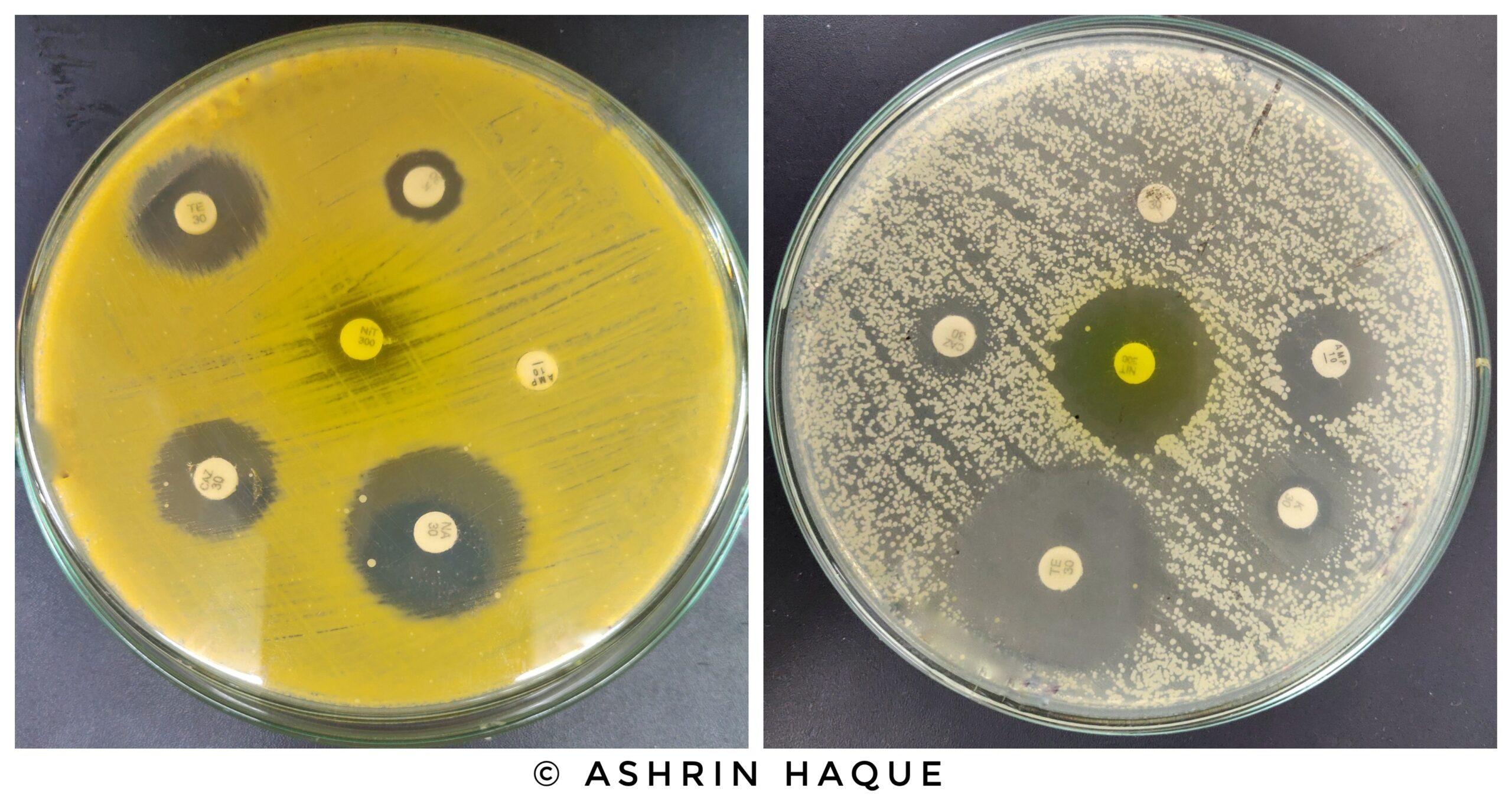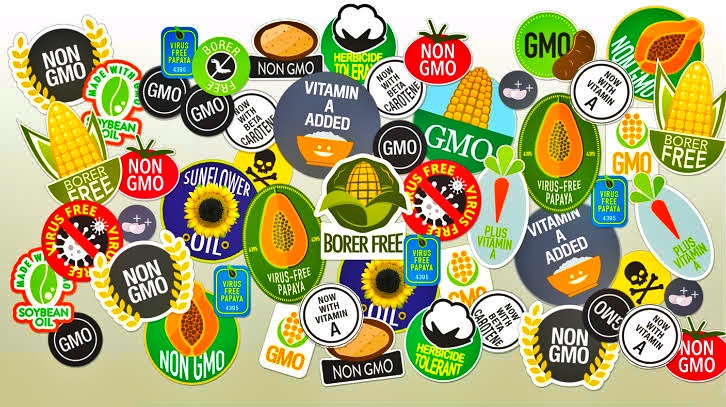Gram stain is a well-known differential staining procedure, and it was developed in 1884 by the Danish bacteriologist Hans Christian Joachim Gram [1]. The role of the Gram staining procedure is crucial in bacteriology. It is used to distinguish between Gram-positive and Gram-negative bacteria based on differential staining with a crystal violet-iodine complex (CV-I) and a safranin counterstain. The cell wall of gram-positive bacteria retain the CV-I complex after treatment with ethyl alcohol and appear purple, but gram-negative bacteria decolorize following such treatment and appear pink. Gram stain is an essential tool for the differentiation and classification of microorganisms [3][4][6].
 Figure 1: Cell wall of Gram-positive Vs Gram-negative bacteria.
Figure 1: Cell wall of Gram-positive Vs Gram-negative bacteria.
Source: https://images.app.goo.gl/8Y9XaYpVmfURuh9g7
It is already known that Gram-positive bacteria retain the color of crystal violet or the color of the primary stain and show the purple color. Gram-negative bacteria retain the color of safranin or counterstain and show pink color. The key difference between Gram-positive and Gram-negative bacteria lies in their cell wall structure composition. The cell wall of Gram-positive bacteria contains a thick peptidoglycan layer with teichoic acid, which retains the color of crystal violet. The Gram-positive bacteria show purple color after the observation under the microscope. Compared with Gram-positive bacteria, Gram-negative bacteria possess a thin peptidoglycan layer with an absence of teichoic acid, which helps to stain the color of the counterstain in pink. So, the main reason for showing different colors is the thick peptidoglycan layer which retains the color of crystal violet for Gram-positive and on the other hand, the thin peptidoglycan layer is responsible for stacking the primary stain in between the inner and outer membrane of the Gram-negative bacteria and for this, they show the color of counterstain which is pink[2][3].
At least three chemical reagents are applied sequentially to a heat-fixed smear in a differential straining procedure. First, the primary stain is used, and its function is to impart its color to all cells. After that decolorizing agent is used to create color contrast; based on the chemical constituents of the bacterial cell wall, the decolorizing agent may or may not remove primary stain from entire cells or specific cell structures. Finally, the counterstain is used that has a contrasting color to that of the primary stain [5].
Four chemical reagents are essential for Gram staining. Crystal violet is used as a primary stain, gram’s iodine is a mordant, ethyl alcohol is a decolorizing agent, and, finally, safranin as a counterstain. For Gram staining, at first heat-fixed smear is prepared with a fresh bacterial culture. Next, Crystal violet dye is used, and it stains all the cells violet. After that, Gram’s iodine is used, which function as a mordant. It binds to the primary stain to form an insoluble crystal violet-iodine complex (CV-I), and all cells will appear purple-black. Only in Gram-positive cells, the CV-I complex binds to the magnesium ribonucleic acid component of the cell wall and form the magnesium ribonucleic acid-crystal violet-iodine complex (Mg-RNA-CV-I). The complex is more difficult to remove than the CV-I complex of Gram-negative cells. In the third step of the Gram staining procedure, ethyl alcohol (95%) is used as a decolorizing agent that functions as a lipid solvent and as a protein dehydrating agent. Gram-positive cells have low lipid concentration, which is essential for the retention of the Mg-RNA-CV-I complex. The lower amount of lipid is readily dissolved by alcohol treatment, forms minute cell wall pores, and is then closed by dehydrating effect of alcohol. Gram-negative bacterial contain higher lipid concentration in the outer layer of cells, do not close appreciably on dehydration of cell wall protein, results in the release of CV-I complex, and cells become unstained. Finally, the final reagent safranin is used as a counterstain to stain only the colorless or unstained cells. Gram-negative cells undergo decolorization, so only they absorb the counterstain and become pink. Gram-positive cells retain the purple color of the primary stain[1][3][4].
 Figure 2: Steps involved in Gram staining
Figure 2: Steps involved in Gram staining
Source: https://images.app.goo.gl/RzEnFhcESLMgTjU99
The overall procedure of the Gram stain is completed in four steps. Before starting the whole process, a smear is needed to be prepared with the help of a loop. Then the smear needs to be heat-fixed so that the bacteria does not wash out while washing. At first, the primary stain, crystal violet, is applied on the smear for 1 minute and then washed out with water. Then the Gram’s Iodine is applied as mordant for another 1 minute and again washed out with the help of water. After that, the decolorization is done using Ethyl Alcohol (95%) by adding it drop by drop on the smear until the color of crystal violet fails to wash from the smear. Finally, the counterstain, safranin, is applied for 45 seconds, and then it is also washed with water. After air-drying the glass slide, it is observed under the oil immersion lens of the microscope [6]. Finally, Gram-negative cells are found pink under microscopic observation, and Gram-positive cells are purple. Based on a microscopic view, differentiation and classification of microorganisms can be possible. Among all the steps, heat fixation and decolorization are the most crucial. If the smear gets overheated, the organism may show false results as there is a high chance of degradation of the cells for high heat.On the other hand, it is essential to remember that the decolorization step is considered a critical phase because over decolorization will lead to primary stain loss, resulting in Gram-positive cells appearing Gram-negative, and less decolorization may create the opposite scenario [5].Another big thing is to use a new culture that is not older than 24 hours. As culture ages, Gram-positive organisms lose their ability to retain primary stain and may appear Gram variable, some cells will appear purple, and some will appear red [5]. Individual skills are essential for the differentiation and classification of microorganisms using the Gram staining procedure.
References:
1. Coico, R., 2006. Gram staining. Current protocols in microbiology, (1), pp.A-3C.
2. Lakna, 2017. Difference Between Gram-Positive and Gram-Negative Bacteria | Definition, Cell Wall Structure, Characteristics. [online] Pediaa.com. Available at: https://www.pediaa.com/difference-between-gram-positive-and-gram-negative-bacteria/amp/
3. Moyes, R.B., Reynolds, J. and Breakwell, D.P., 2009. Differential staining of bacteria: gram stain. Current Protocols in Microbiology, 15(1), pp. A-3C.
4. Smith, A.C., and Hussey, M.A., 2005. Gram stain protocols. American Society for Microbiology, 1, p.14.
5. Tagesu, A. 2018. Microbiology examination. International Journal of Veterinary Science and Research, (1), pp.65-077. Available at: https://www.peertechzpublications.com/special-issue-articles/IJVSR-S1-110.pdf
6. Tripathi, N. and Sapra, A. (2020). Gram Staining. [online] PubMed. Available at: https://www.ncbi.nlm.nih.gov/books/NBK562156/.
“Since the article has been written to reflect the actual views and capabilities of the author(s), they are not revised for content and only lightly edited to be confirmed with the Learn life sciences style guidelines.”









Wow! Absolutely loved it! Learned a lot. Big props to the authors!
It is appropriate time to make a few plans for the future
and it’s time to be happy. I’ve read this post and if I could I want to
suggest you some fascinating issues or tips. Perhaps you
could write subsequent articles relating to this article.
I wish to read more issues about it!
Sweet internet site, super design, rattling clean and use friendly.
I’ve recently started a blog, the info you offer on this site has helped me greatly. Thank you for all of your time & work.
Those are yours alright! . We at least need to get these people stealing images to start blogging! They probably just did a image search and grabbed them. They look good though!
I was curious if you ever thought of changing the layout of your site? Its very well written; I love what youve got to say. But maybe you could a little more in the way of content so people could connect with it better. Youve got an awful lot of text for only having 1 or 2 pictures. Maybe you could space it out better?
Im grateful for the blog article.Really looking forward to read more. Want more.
Greetings! Very helpful advice in this particular post! It is the little changes that make the most significant changes. Thanks for sharing!
I must thank you for the efforts you have put in writing this blog. Im hoping to check out the same high-grade blog posts from you in the future as well. In fact, your creative writing abilities has encouraged me to get my own, personal site now 😉
As I website owner I believe the content material here is really good appreciate it for your efforts. https://merkitevdeneve.com/
Hi there! I could have sworn Ive visited this web site before but after browsing through many of the articles I realized its new to me. newsmax bias
Thank you for great content. I look forward to the continuation. mecca live
I appreciate you sharing this blog post. Thanks Again. Cool.
This is really interesting, You’re a very skilled blogger. I’ve joined your feed and look forward to seeking more of your magnificent post. Also, I’ve shared your site in my social networks!
very informative articles or reviews at this time.
There is definately a lot to find out about this subject. I like all the points you made
Pretty! This has been a really wonderful post. Many thanks for providing these details.
Wow! I really enjoyed it! learnt a lot. Congratulations to the authors!
I agree with your point of view, your article has given me a lot of help and benefited me a lot. Thanks. Hope you continue to write such excellent articles.
You’re so awesome! I don’t believe I have read a single thing like that before. So great to find someone with some original thoughts on this topic. Really.. thank you for starting this up. This website is something that is needed on the internet, someone with a little originality!
There is definately a lot to find out about this subject. I like all the points you made
I very delighted to find this internet site on bing, just what I was searching for as well saved to fav
This is really interesting, You’re a very skilled blogger. I’ve joined your feed and look forward to seeking more of your magnificent post. Also, I’ve shared your site in my social networks!
I’m often to blogging and i really appreciate your content. The article has actually peaks my interest. I’m going to bookmark your web site and maintain checking for brand spanking new information.
I really like reading through a post that can make men and women think. Also, thank you for allowing me to comment!
naturally like your web site however you need to take a look at the spelling on several of your posts. A number of them are rife with spelling problems and I find it very bothersome to tell the truth on the other hand I will surely come again again.
Great post Thank you. I look forward to the continuation.
I’m often to blogging and i really appreciate your content. The article has actually peaks my interest. I’m going to bookmark your web site and maintain checking for brand spanking new information.
I like the efforts you have put in this, regards for all the great content.
I very delighted to find this internet site on bing, just what I was searching for as well saved to fav
For the reason that the admin of this site is working, no uncertainty very quickly it will be renowned, due to its quality contents.
Thanks for a marvelous posting! I genuinely enjoyed reading it, you are a great author.I will always bookmark your blog and will often come back down the road. I want to encourage continue your great job, have a nice weekend!
Cool that really helps, thank you.